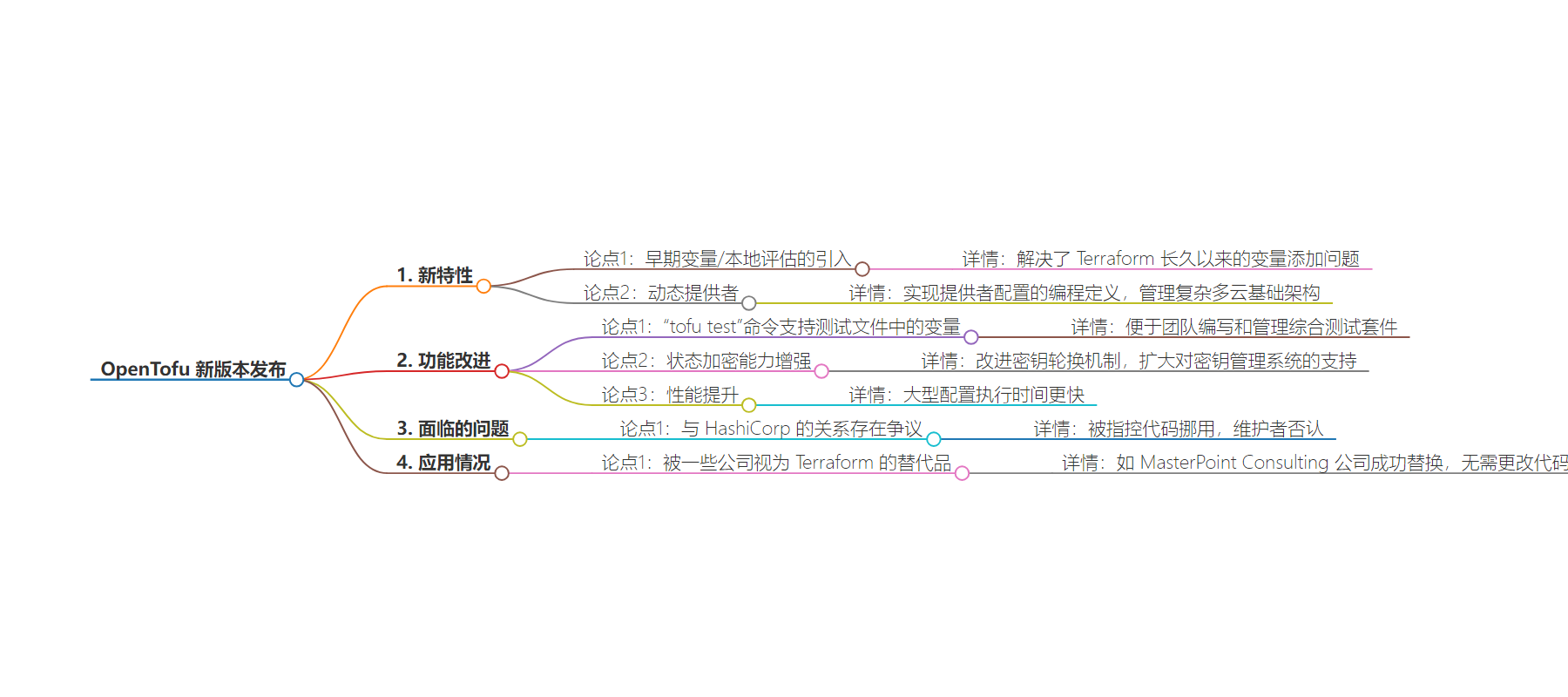包阅导读总结
1.
“`
关键词:OpenTofu、Terraform、版本 1.8、新功能、争议
“`
2.
OpenTofu 发布新版本 1.8,带来诸多新功能,挑战 Terraform 的主导地位。新版本引入早期变量/本地评估和动态提供者等,还改进现有功能,如测试命令、状态加密和性能。虽与 HashiCorp 关系有争议,但发展势头良好,被一些公司视为 Terraform 的替代。
3.
– OpenTofu 发布新版本 1.8
– 新功能
– 早期变量/本地评估,解决了过去 Terraform 的相关问题
– 动态提供者,方便管理复杂的多云基础设施
– 现有功能改进
– “tofu test”命令支持测试文件中的变量
– 增强状态加密能力,改进密钥管理机制
– 性能提升,执行速度加快
– 面临的问题
– 与 HashiCorp 关系紧张,被指控代码挪用,但维护者否认
– 替代情况
– 被一些公司视为 Terraform 的直接替代,如 MasterPoint Consulting 公司的成功案例
思维导图:
文章地址:https://thenewstack.io/new-opentofu-release-challenges-terraforms-dominance/
文章来源:thenewstack.io
作者:Steven J. Vaughan-Nichols
发布时间:2024/7/30 18:46
语言:英文
总字数:680字
预计阅读时间:3分钟
评分:87分
标签:OpenTofu,Terraform,基础设施即代码,动态提供程序,变量/局部变量评估
以下为原文内容
本内容来源于用户推荐转载,旨在分享知识与观点,如有侵权请联系删除 联系邮箱 media@ilingban.com
The new OpenTofu comes with features developers have been asking for for years.
In a move that’s sure to catch the attention of the Infrastructure as Code (IaC) community, OpenTofu has released version 1.8, packed with features that users have been clamoring for since the project forked from HashiCorp’s Terraform.
This latest release isn’t just another incremental update. Its headline feature is the introduction of early variables/locals evaluation. As Flavius Dinu, OpenTofu-friendly Spacelift developer advocate, wrote in a blog post, “This is by far the most highly anticipated feature of the release. Seven years ago, one of the issues with Terraform was that you couldn’t add variables to the Terraform block. There were some hacky workarounds that you could use, but they never felt right.”
Now, he continued, it’s easy. In addition, you can now “use variables or locals when using module sources and versions. Previously, changing the module versions was difficult from an automation standpoint because you always needed to use different workarounds.”
Another new feature, dynamic providers, has been on many developers’ wish lists for years and is here now. Dynamic providers enable you to create programmatic definitions of provider configurations. This opens up new possibilities for managing complex, multicloud infrastructures. It’s a significant step forward that could give OpenTofu an edge in the increasingly competitive IaC landscape.
Functionality Improvements
OpenTofu is doing more than just flexing its muscles with new features. The 1.8 release also brings improvements to existing functionality. The “tofu test” command, introduced in version 1.6, now supports variables in test files, making it easier for teams to write and manage comprehensive test suites for their infrastructure code.
Security-conscious users will appreciate the enhancements to OpenTofu’s state encryption capabilities. Based on the end-to-end encryption introduced in version 1.7, OpenTofu 1.8 offers improved key rotation mechanisms and expanded support for key management systems. In an era where infrastructure security is paramount, these improvements are more than bullet points on a feature list — they’re essential tools for protecting sensitive data.
The OpenTofu team has also been busy under the hood, with performance improvements that promise faster execution times for large configurations. While benchmarks can be tricky in IaC, early reports suggest noticeable speed gains, especially for complex setups.
Smooth Sailing?
However, it’s not all smooth sailing for OpenTofu. The project continues to navigate choppy waters in its contentious relationship with HashiCorp. Recent accusations of code misappropriation from Terraform have added drama to the release. OpenTofu maintainers continue to strongly deny any wrongdoing. This ongoing tension serves as a reminder of the complex dynamics at play in the open source world, especially when commercial interests are involved.
Despite the controversy, OpenTofu’s momentum continues apace. With over 23,000 GitHub stars and a growing list of high-profile adopters such as Oracle, the project is rapidly establishing itself as more than just a Terraform alternative — it’s becoming a force to be reckoned with in its own right.
Drop-in Replacement
Mind you, some companies still see it primarily as a drop-in replacement for Terraform. MasterPoint Consulting CEO Matt Gowie, for example, reported in a LinkedIn post that when his company “upgraded one of our client’s IaC codebases from Terraform.” Gowie detailed:
- In this repo, there are 39,764 lines of Terraform code across 485
*.tffiles. - There are 53 root modules in the codebase.
- There are 90 root module instances (read “state files”)
- If we add up all the resources in those state files, there are ~2400 resources under management.
How many errors did we run into across all that Terraform? How many changes to the actual Terraform code did we need to make to accommodate tofu? NONE. ZERO.”
OK, that’s impressive.
Whether you’re a longtime Terraform user considering a switch or an IaC newcomer, OpenTofu 1.8 makes a compelling case for giving this open source upstart a serious look. Just be prepared for drama along the way. After all, what’s open source without a dash of controversy?
YOUTUBE.COM/THENEWSTACK
Tech moves fast, don’t miss an episode. Subscribe to our YouTubechannel to stream all our podcasts, interviews, demos, and more.
